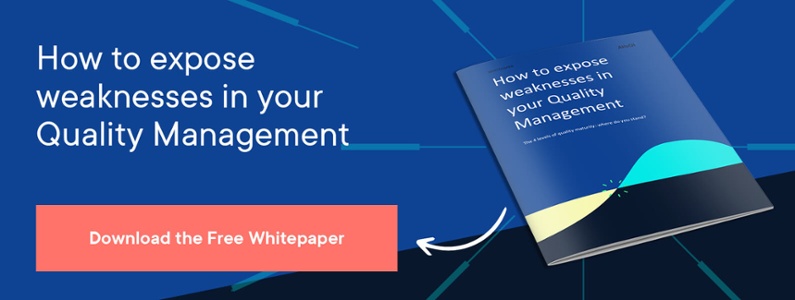Solvers help you monitor quality, apply SPC, manage equipment, and ensure traceability.

Evaluate your Quality Intelligence Maturity – Part Two: From divergence to omnipresence
ONE of the reasons why we believe it is worthwhile for manufacturers to assess their Quality Intelligence with the help of our Maturity Matrix is that the results are without fail surprising. This is in part because different departments experience quality management quite differently, and some business functions may even feel a total disconnect with Quality Control. This is odd, to say the least because if the quality isn’t there, everyone is out of a job.
Quality can have an image problem, and this survey is one of the ways you can begin to reach out. Don’t say ‘omnipresence’ to your co-workers! Say that you want everyone to help you boost quality and that better quality management means better margins, fewer recalls and complaints, less stress on the shopfloor, shorter meetings, a better relationship with suppliers, and so on.
The key attributes
Our survey asks you to class your Quality Management in one of four stages of maturity for 8 key attributes. What sets one level of maturity apart from another is the degree to which you have (or have not) integrated and automated your quality processes. The key attributes speak for themselves and are broad enough for everyone in the business to understand and score, even if that score is wholly negative because the respondent doesn’t know how you measure your performance or has scant access to your quality analyses. In terms of your self-assessment, such an outcome is a massive positive especially if quality leaders in their turn were unaware that such gaps existed.
Everyone has strong views on Process Execution. While not many manufacturing businesses will operate a completely ad hoc and isolated quality management program, every quality professional will recognize this state of affairs and lived through it at some stage of their careers. What defines Level 1 for this attribute is a complete lack of consistency. It is not that problems are left unresolved (the goods leave the factory gate), but they are never solved in quite the same way. The organizational will and energy to impose consistent processes and solutions are lacking. Expect fireworks here: the variation in scores across departments and even within departments can be dramatic.
Process Management is perhaps the most clear-cut key attribute. But here too the spread of ratings will provide food for thought. You may use spreadsheet-based Balanced Score Cards (Level 3), but does everyone have access to these spreadsheets, or even know they exist? If you do not have an explicit policy of openness and inclusiveness, do not be surprised if colleagues outside the quality department put your company at Level 1 for this attribute.
Organization. We have already touched on the importance of integration: systems, processes, products and people have to be connected. That can’t only mean that everyone has access to a dashboard with real-time quality metrics; end-users have to use and be actively involved. You are doing this survey because you believe you can take quality management up a notch so you will want to know if senior management is satisfied with its commitment to quality. A business case is only as compelling as senior management’s enthusiasm for it. But the survey will give you the insights you need to direct your case.
It is complicated enough to control the quality of your own products without having to police those of your suppliers. We see time and time again that product recalls have Supply chain integration problems at their origin. In our experience, many manufacturers are stuck in Level 2 for this category; any problems that arise are resolved by email or even over the phone. But given that the data exchange between you and your suppliers is manual and therefore not reliable, would you even know there was a problem?
Manufacturers that have implemented a quality management solution and reached Quality Intelligence maturity almost always cite Data management and Analytics & reporting as the areas where they have seen the largest and most eye-opening improvements. Manufacturers with a large product base who keep track of quality in Excel spreadsheets (Level 2) only really monitor a handful of products, probably those that have historically deviated most or most often. If this is the case in your company, expect a rash of low scores for these categories. The scores will not come as a surprise to you but will help lend urgency to your business case.
The business case for an investment in quality management should not hinge on money, but equally, it isn’t good enough to rely solely on the argument that not investing would cost a lot more in the long run, true though that is.
The whole issue of quality management and cost is interesting and complex. We shall discuss it in our next and final blog on Quality Intelligence Maturity.
How mature is your quality management?
In this era of smart manufacturing, quality will become smart as well. This transition will not happen overnight and this will not happen in a linear way. Our Quality Intelligence Maturity Model presents a springboard to change and asks organizations to self-assess to what extent they are ready for Quality Intelligence and to leverage tomorrow’s possibilities.
The Quality Maturity Model is designed to highlight the strengths and expose potential weaknesses of all aspects of your quality management, giving you the input necessary to strategize for positive change.


